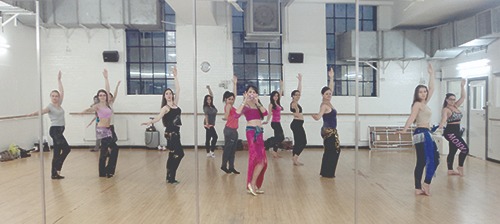The early 20th century was the golden era of belly dancing. This was a time when belly dancing scenes were integral parts of films.
These scenes were enacted by iconic dancers, such as Taheia Karioka, Samia Gamal and Nagwa Fouad.
Belly dancing has never been immune from criticism, especially by conservative members of society. Nonetheless, belly dancing training sessions have become very popular among different classes of people, especially in gyms.
Women of all ages are keen to attend these sessions, even as they do not have plans to become professional belly dancers or pursue a belly dancing career.
Faten Mohamed, a trainer at a gym in the southern Cairo district of Maadi, has been seeing the growing popularity of belly dancing sessions for a long time now.
“Most gyms provide belly dancing classes to women,” Mohamed told the Egyptian Mail. “They provide safe places for veiled women too.”
At the gym where Mohamed works, belly dancing has already become the most important class for the women frequenting the place.
Mohamed and other gym trainers have reached this conclusion, having seen growing demand on the class by women.
“We have a woman asking about the class every now and then,” Mohamed said.
However, this is more than just an entertaining activity. Belly dancing is a good way for women to lose weight.
Mohamed also bore witness to many of the women participating in the class who had already lost weight and very noticeably at that.
“It enhances the movement and flexibility of the body,” Mohamed said of belly dancing. “It also raises self-confidence and improves the mood of the dancers.”
Each one hour of dancing can help dancers lose approximately 300 calories, according to some trainers.
Belly dancing has been an entertaining form of art in Egypt for many decades now.
This Arab country is the cradle of belly dancing, boasting a large number of belly dancing icons. These people are talked about as a term of reference in this art, even as some of them passed away many years ago.
Gamal and Karioka come on top of these icons. They used to have their own dancing styles. They represent separate schools in this art form.
Gamal’s dancing was characterised by a mix of oriental and western moves. Karioka was fond of ancient dancing styles, but she introduced these styles in a modern manner.
In recent years, Egypt attracted a large number of foreign dancers who introduced some courage to dancing when it comes to costumes.
The same foreign dancers also introduced new moves that in some ways changed the direction of oriental belly dancing.
This has drawn objections from some people who accuse these dancers of dancing in a lewd manner.
Meanwhile, belly dancers suffer stigma in society, even as they are popular in the cinema world.
This social rejection is manifested in reaction inside some families to the desire by some of their female members to learn belly dancing.
Belly dancing trainer Touqa Diab attributes this social rejection to the association between this art form and immorality in the minds of some people.
“The fact is that belly dancing is a fine art,” Diab told this newspaper. “Some women dance for their health, nothing more.”
She described belly dancing as an ‘affordable’ sport that can be practiced at home.
“Conservative women can dance, given the relaxing effect dancing can have on them,” Diab said.
She said gyms always enclose the areas where women train in belly dancing with complete privacy.
Most of the gyms, she said, do not allow mobile phone use inside them during the training.
Diab has noticed that most of her trainees forget their social and work problems as soon as they start shaking their bodies during the training.
This is why she and fellow trainers are viewed by some trainees as their saviors.
“They look at the positive energy I exhibit as I dance to teach them and try to get inspiration from it,” Diab said of her trainees. “My advice to women is: Dance for 30 minutes every day. It will give you health and reenergise you.”






Discussion about this post